Best File Splitter for Windows [Out of 15 Tested in 2023]

As time moves on, the size of software and files found on your computer gets bigger. A photo will have more pixels in it and be larger, video files are now being distributed in 4K which means bigger file sizes than before. The same applies to games, some can now be as much as a 200GB download on platforms such as Steam. Applications are also growing, the latest Microsoft Office installation is now much bigger than it used to be.
As everything grows in size, it becomes more of a problem when you are trying to move or copy the files to a more restricted medium. For instance, you might be trying to send a video file via email which has an attachment size limit. Or you could be trying to backup or copy large files, such as ISO images, onto optical media or flash drives. If the file is too big for the space limit you have available, it needs to be split into separate parts.
Splitting files into smaller parts that can then be joined together again, later on, is done all the time on the internet. It’s also quite common to split a large file when you have to fit it onto several CDs, DVDs, or even floppies. Curiously Windows itself has the capacity to join already split files, but can’t split the file in the first place. For that you need a third party method, here are 8 ways for you to do it. All methods were tested on Windows 7 and 10.
1. Fastest File Splitter and Joiner (FFSJ)
FFSJ is small, efficient, and easy to use and comes as either a Lite or Standard version. Lite is a portable executable while the Standard installer version includes the context menu option that can split and join by right click. FFSJ also has a command line interface so files can be split and joined from batch scripts or the Command Prompt.
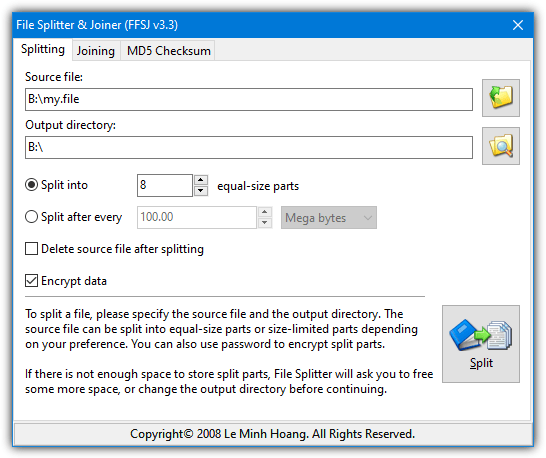
Splitting a file is easy and you only need to drop a file onto the window or manually locate it, choose a different output directory if required, and set the split method. The file can be split according to a specific number of parts or a specific size. The Encrypt data option is useful as only those that know the password can rejoin the files (you must rejoin the files with FFSJ).
For joining files you only have to drag and drop or locate the first file in the set and supply a save to directory. A password will be required if you encrypted the files. The MD5 Checksum tab allows you to get the checksum of the file before splitting, then a joined file can be verified to see if its checksum matches.
Download Fastest File Splitter and Joiner
2. KFK
KFK is by KC Softwares who also make other well known tools like the software update monitor Sumo. In addition to splitting and joining files, KFK also has an option to burn the files to disc (if you have the shareware VSO CopytoDVD software) and also offers disk spanning by splitting a file over multiple floppy disks.
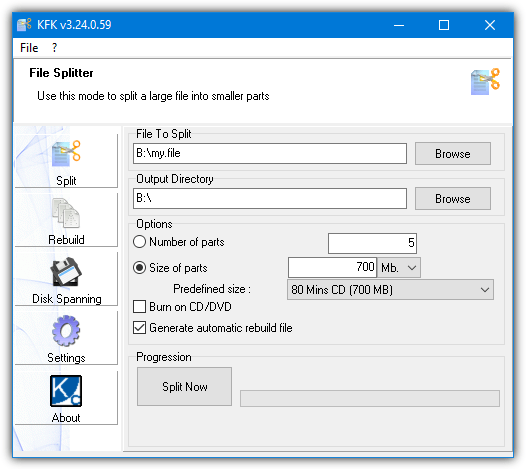
It’s possible to drop a file onto the KFK window or you can browse for one manually. For splitting, you can choose either to set a specific number of parts or a specific size of each part. The “Generate automatic rebuild file” checkbox creates a batch file with the files so you can join them together without using KFK.
Make sure to download the Lite or portable version of KFK. In the past, KC softwares have bundled adware with their installers. At the time of writing, they appear to be adware free but be aware when downloading.
3. GSplit 3
GSplit is definitely the program with the most advanced options here. Not only can it automatically span a file across several removable devices (floppies, USB flash drives, etc), GSplit can also create custom tags for the files and a custom self uniting program. There’s even a batch option where a number of files can be split one after the other (using the Several Files button).
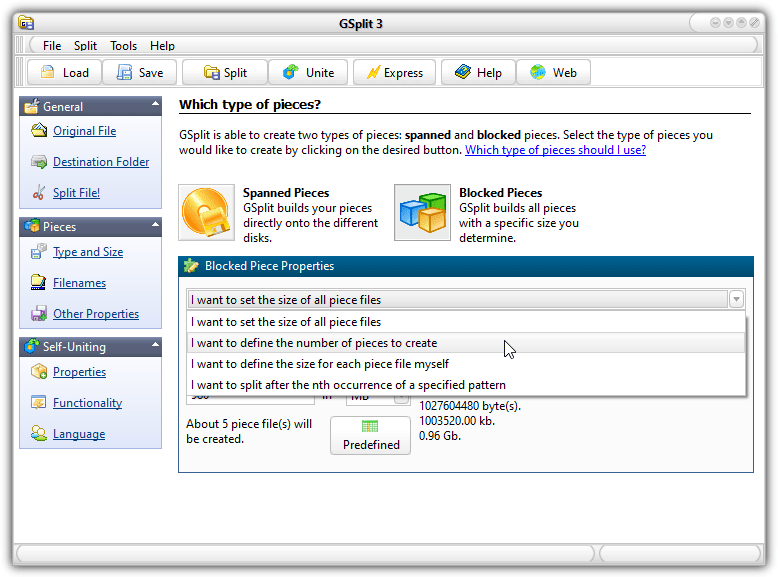
There are four standard split methods; by numbers of files, by the size of each file, entering the size of each file individually, or even splitting a text file by line. The self uniting function (SFU) adds an executable to the files so they can be joined without GSplit.
The SFU file can be customized with your own messages, a picture, a chosen destination folder, run a program after splitting and auto start/end. The Express button is a faster way to quickly split a file from a single window. Both installer and portable versions of GSplit 3 are available.
4. Puran Splitter
Splitter is also part of the Puran Utilities tweaking software but this is the standalone version. It’s unfortunate that the program has to be installed but you can easily copy the folder from Program Files and then uninstall to create a portable version. Delete the file “Default.cjstyles” from the program folder if you prefer not to have the light blue theme.
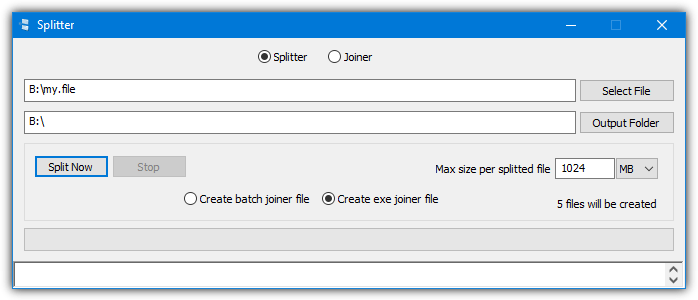
Splitting a file is self explanatory and you simply drop or browse for the file to split, browse for an output folder, set the size of each file, and press the button. Sizes are in Kilobytes or Megabytes so multiply Megabytes by 1024 to use Gigabytes.
A useful feature is the option to either create a batch file to rejoin the files back together or create an executable. Either option works without the need for Puran Splitter. The batch join option uses the Windows Copy command which is useful to get around any restrictions that don’t allow an unknown executable to run on the computer.
5. Split Files Using an Archiving Program (PeaZip)
One of the most known methods of splitting files into multiple parts is by using a file archiver. Most archiving software has the ability to create a multi part Zip or 7z archive. We’re looking at PeaZip because it can actually split files by creating a multi part archive or using the standard method of splitting the file like the tools above. PeaZip is also a very good general archiver with a portable version if you would rather not install it.
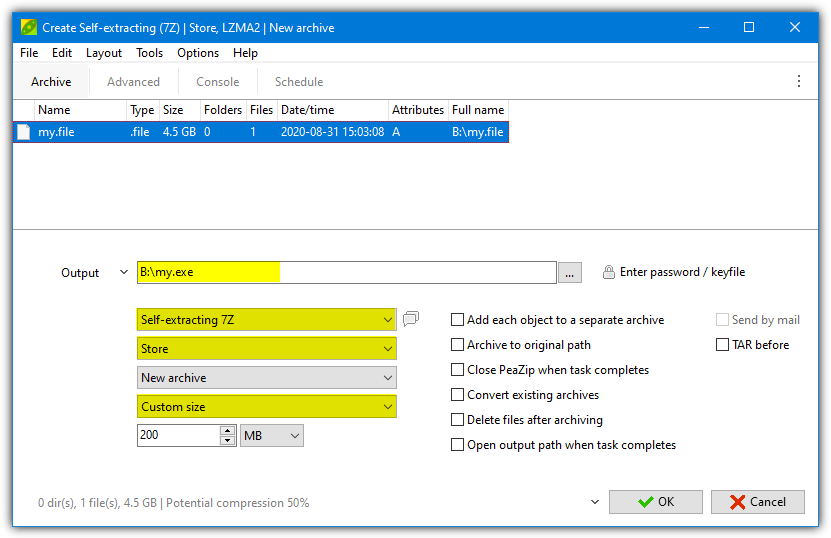
To create a multi part archive, press Add, and drop the file onto the window. Choose where to save the split files, and in the dropdown boxes select Self-extracting 7Z, and Store. Select the split file size from one of the presets or choose Custom and enter a specific size in KB, MB, or GB.
With the self extracting 7Z you can join the files back together without an archiver installed. If that’s not required, use the 7Z or Zip methods instead. To create a standard split file, choose Split in the top drop down and pick the split size in the bottom drop down and start the process.
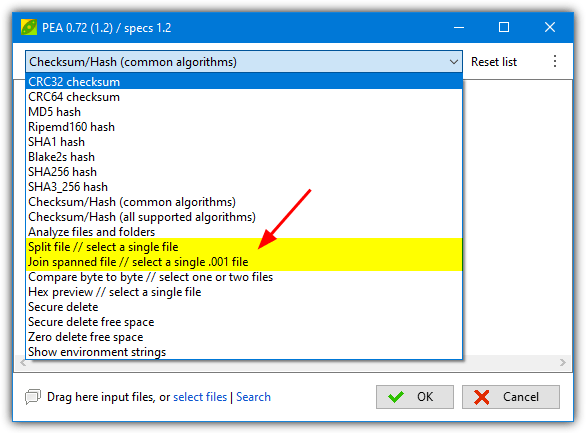
An alternative split window is in Tools > PeaUtils although here the output path is locked to the same as the input file. The PeaUtils window is also where you can join split parts together again. Click the drop down and select Join spanned file, then locate the first file in the set (.001) or drop it onto the window.
PeaUtils is a standalone program that doesn’t require PeaZip to work. Therefore, you can use split, join, or any other options available in the drop down without using or installing PeaZip.
Download PeaZip | Download PeaUtils
6. Split And Join Files With a File Manager (FreeCommander XE)
A number of free programs like NexusFile, Double Commander, and Explorer++ have the ability to split and join files. We’re looking at FreeCommander XE because it has the option of creating a batch file that can join the files together using the Window Copy command without the need for FreeCommander or another tool.
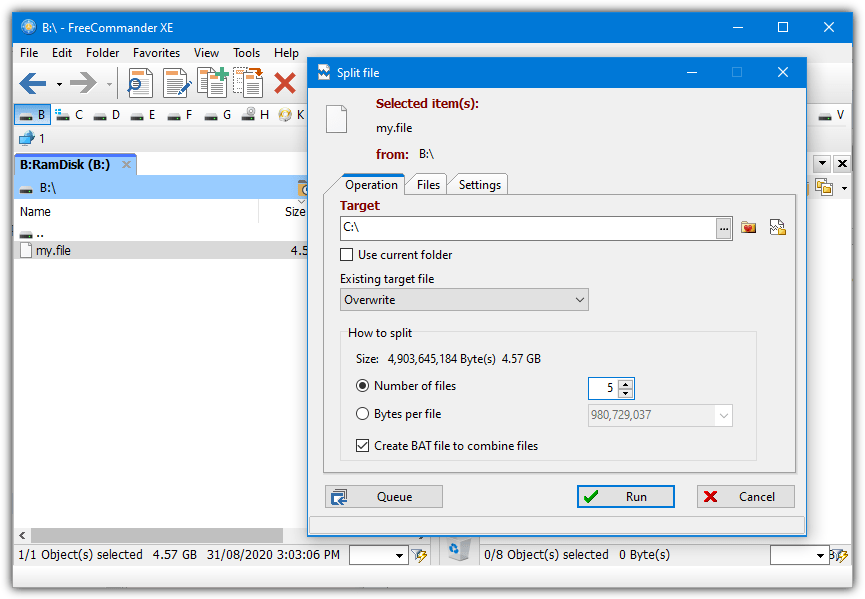
Select the file to split within FreeCommander and then go to File > Split (Ctrl+Shift+I). In the Split File window, select the target folder and whether to split the file to a specific number of parts or a set size for each file. Use “x GB” in the size box to work in Gigabytes. An interesting feature is the ability to send the split parts to separate folders, you can do that by pressing the icon to the far right of the target box.
Optionally check the Create BAT file box to include the self joining script and press Run to start. Previously split files can be joined together from running the batch script or from within FreeCommander. Just select all the parts and go to File > Combine files, select the save folder for the rejoined file, and press Run.
7. Split and Join Files Webpage
The method may sound a little odd, but this website works in a similar way to many of the tools above. All you have to do is drop a file onto the page and JavaScript is used to split it into parts with the specified size. No files are uploaded or downloaded using the internet and the whole process is done locally on your computer.
When dropping a file onto the window make sure it’s dropped inside the gray area where it says “Drop files here…”. A new box will pop up to select the size for each file, Bytes, Kilobytes, or Megabytes are accepted. The green numbered buttons are the split files and you simply click on each to download it or click “Save all in a Zip” to get the files in a single package.
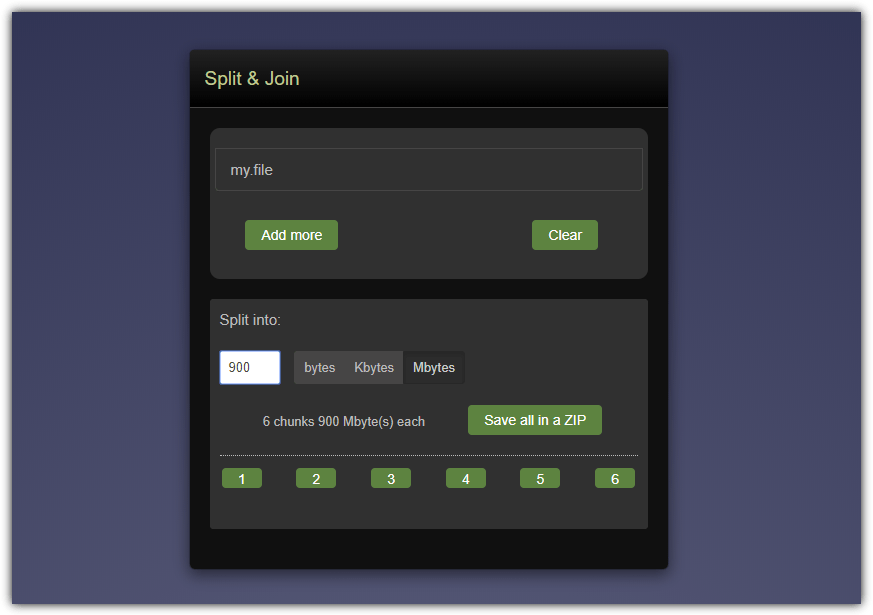
To join everything back into a single file drop all the parts onto the gray box, select a filename if the default is not adequate, and press Save. You can also add files to the list from other locations by using the Add more button. Split and Join struggles a bit when dealing with larger files in the Gigabytes. It’s most useful for files less than a few Gigabytes that you just want to split quickly, and you only need a web browser to do it.
8. Split And Join Files From The Command Line
It’s quite strange that Windows itself doesn’t have any built in options to split files into parts but it does have more than one way to join files together. Files can be joined by the Copy command (which is what some of the options above use) or even the Type command.
If you want to split a file from the command line or a script, a third party tool is required. However, there does seem to be a lack of command line tools around that actually work properly. Here are two options to split files from the command line, the first option in our list (FFSJ) also has command line options.
File-Splitter
This is one of the very few command line file splitters we found that worked. File-Splitter also has a useful feature for those wanting to split text files because it has a split by line function.
Fsplit -split 200 mb B:\my.file
Fsplit -split 5000 l B:\my.file
The first command will split my.file into 200 Megabyte chunks, you can also use Gigabytes (gb), kilobytes (kb), or Bytes (b). The second command splits a text file every 5000 lines. Make sure to use the full path to the file, even if the file is in the current directory. If you supply no arguments, File-Splitter will popup a small GUI.
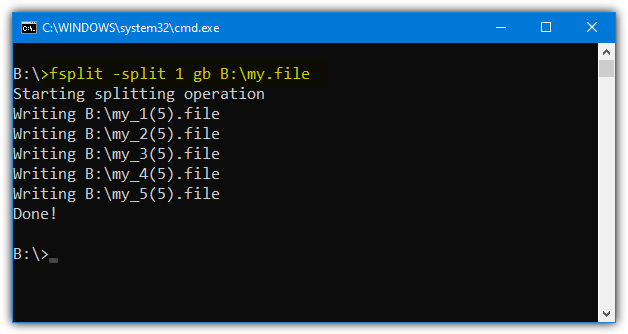
Files will be output with a name, then a part number, then the total number of parts in brackets. The output for a 500MB file using the first command will produce my_1(3).file, my_2(3).file, and my_3(3).file. The renaming scheme can be changed with additional arguments, read the website for more information.
Sadly, there is no built in join option so you will have to use the Windows Copy command.
Copy /B file1+file2+file3+file4+file5 my.file
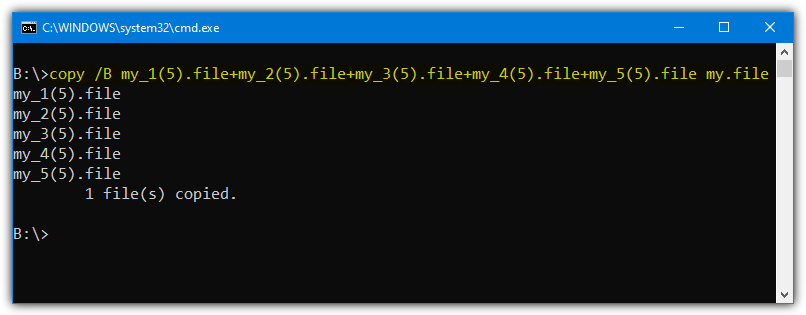
If you are joining a text file with Copy, use /A instead of /B. Joining in this way is obviously a huge pain if you have loads of split files, so it is best used for files where you only split into a few parts.
7-Zip
7-Zip is obviously a hugely popular archiver and you can split files into separate archives with the user interface. You can also use 7-Zip quite easily from the command line to split and join archives. The commands below split my.file into one Gigabyte chunks to a file called raymondcc.7z and then rejoin the parts to a file on the B drive.
7z a -v1g -mx=0 raymondcc.7z my.file
7z e raymondcc.7z.001 -oB:\
The a argument tells 7-Zip to add to an archive, -v supplies the split size, this can be in (b)ytes, (k)ilobytes, (m)egabytes, or (g)igabytes. Use no compression to make the split process much faster (-mx=0), you can add some light compression with -mx=1 or -mx=3. Then the output file name is supplied and lastly the input file to be split.
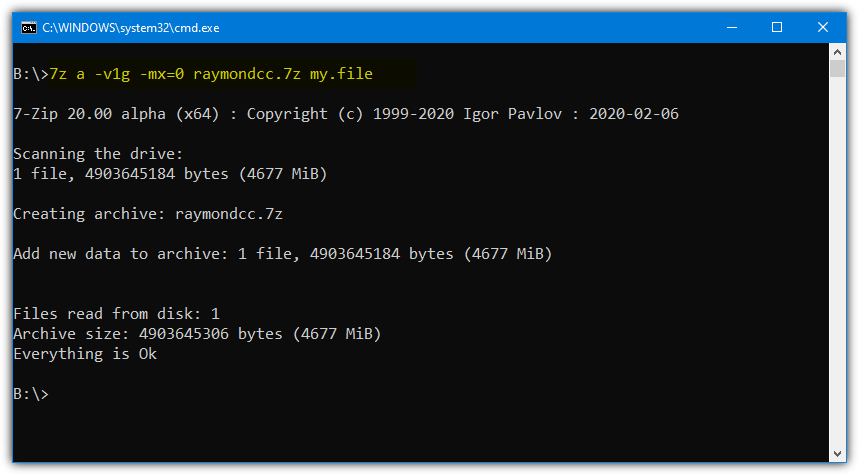
The extract command is easier and only requires the e argument to tell 7-Zip to extract, the first split file name (will end in .001), and the output path. Note there’s no space between the -o argument and the output path.
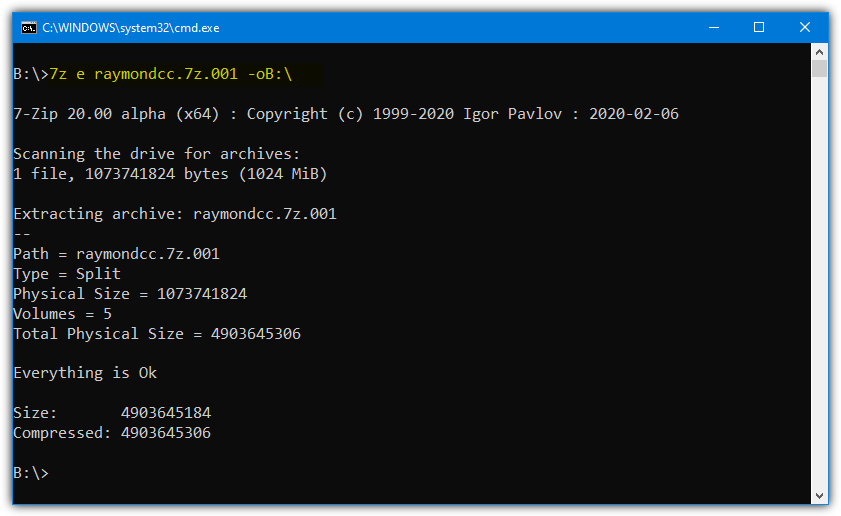
You can also create a self extracting archive that will automatically join the files back together without the need for 7-Zip.
7z a -v1g -mx=0 -sfx7z.sfx raymondcc.exe my.file
The first file created is a small executable and the other files will be the 00x archive files. Double click the exe and it will popup a small window to save the rejoined file at the specified path. 7-Zip can use different archive types, encryption, and many other options, read the help guide for more detail.





User forum
7 messages